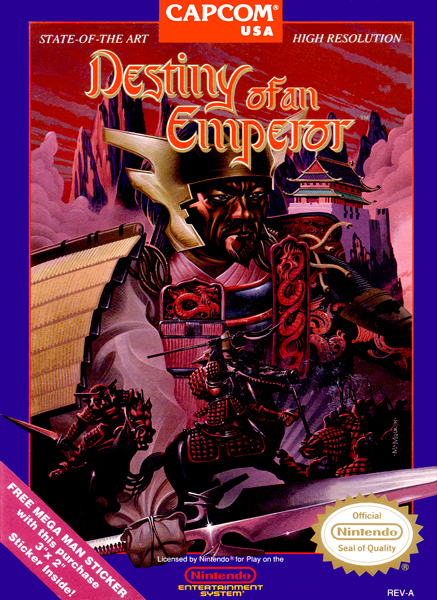
Destiny of an Emperor
System: NES
Release Date: September 1990
Developer: Capcom
Publisher: Capcom
Genre: RPG
Unite 14th century China once again and ascend in Destiny of an Emperor! Liu Bei, Zhang Fei, and Guan Yu are best friends and they make a pledge to fight together and die together. They’ll have a lot of opportunities to do this as they battle rebels, brigands, and pirates while building their army by recruiting generals to work under them. We’ve seen plenty of historical games, but they’ve mostly been of the simulation flavor. That’s what I was expecting, but then I was pleasantly surprised by an RPG!
Everything works in a typical JRPG way. Each character has an inventory where you must equip a weapon and armor pieces. If you don’t remember to equip your weapon at the beginning, you’ll have a lot of trouble defeating any enemies. Once you realize this, battles become a lot more manageable. You have up to five generals with a number of soldiers that represent your hit points. Each general has varying numbers of soldiers, strength, and intelligence.
You can go through the incredibly long process of choosing who you want to attack, or you can leave it up to the AI and click All Out. If it’s a random battle against generic troops, click the auto battle and save your sanity. Stays at the INN are relatively cheap, especially early. In fights where other generals are present, it may be a good idea to manually weaken different troop formations, because attacks become weaker under 100 troops. This goes for both the enemy and you, so keeping your health up becomes important.
Many generals can be recruited through the game. Some come with you if you talk to them. Others require you to defeat them in battle and then bribe them with a horse or money. The famous Lu Bu requires you to give him an item in battle to get him to change sides. You can appoint one of the seven generals you can bring with you at any time as Tactician. This allows your crew to learn tactics, which are magic spells. Each character shares a pool of Tactic Points that runs down quickly if you aren’t mindful. The names of the spells are Anglicized Chinese words that meant nothing to me, requiring the manual to get an idea of what they did.
Once you get a number of generals, keeping them straight becomes difficult. There were many with similar names that I had trouble differentiating. Then trying to remember which generals were strong and which were smart was a pain because there’s no quick way to move among stat menus. If this were the only game I was playing, I can see going through the whole thing, but as it was, this journey lacked a strong pull on me and I quit only about quarter of the way in.
Graphics: 1.5
The sprite work isn’t very appealing. I do like the character portraits, but they seem to have only a few different bases and then slight variations on each.
Sound: 3.5
The music is very good, which I’ve come to expect out of Capcom.
Gameplay: 2.0
This is very standard JRPG gameplay, complete with magic disguised as something not named magic. Very simple go here, fight that guy, rinse, repeat.
Difficulty: 2.5
You can get steamrolled if you aren’t paying careful attention, but it’s totally a linear affair.
Fun Factor: 2.5
If you like the typical JRPG tropes, you’ll get into this game and enjoy yourself.
Overall Rating: 2.4
Destiny of an Emperor earns a C+. This is a solid game from a solid company. Capcom is in a great streak of releases at this point and they aren’t done in 1990, yet!
